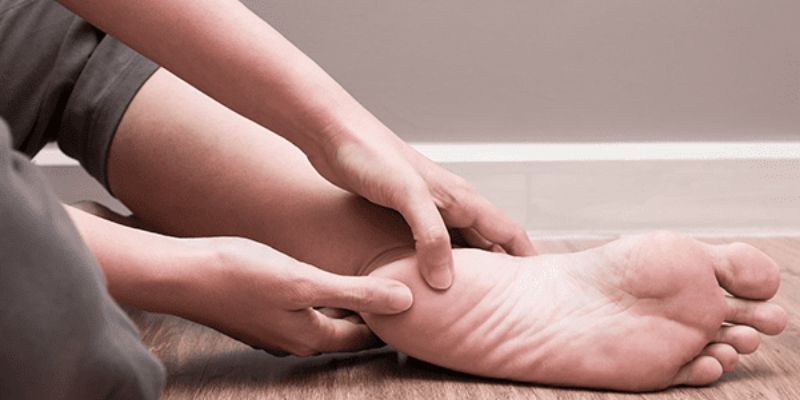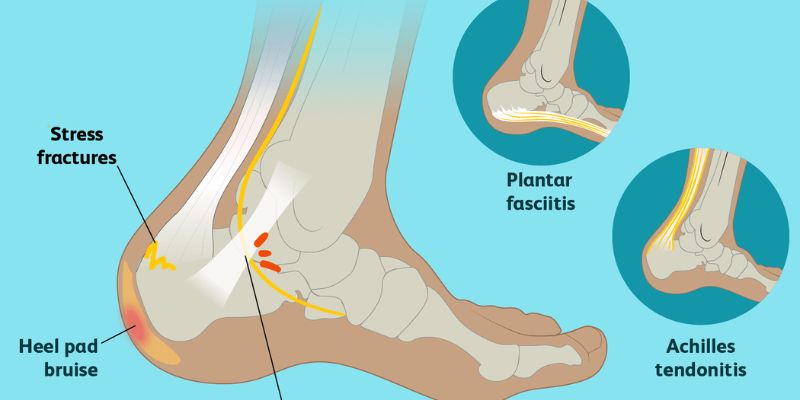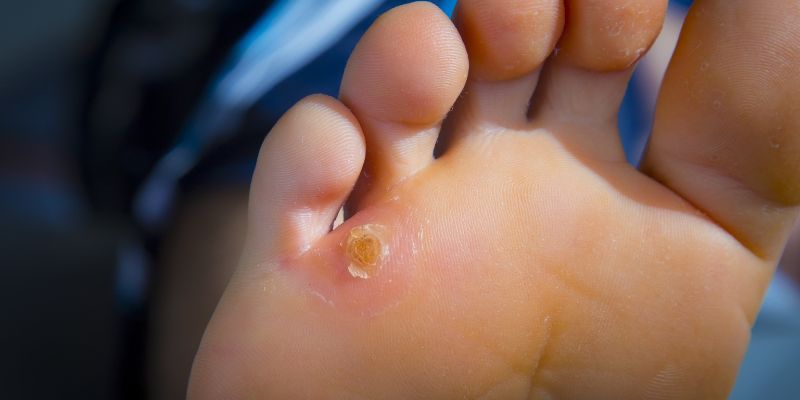Heel Pain Causes and Treatment
Feb 23, 2024 By Madison Evans
Do you experience persistent pain in your knees, ankles, feet, or heels? If so, you're not alone. Heel pain is one of the most common complaints from people of all ages, and it can range from basic discomfort to severe crippling pain that affects your day-to-day activities.
But what causes this type of pain, and what are some possible treatments available? In this blog post, we'll explore the various causes of heel pain, including lifestyle factors and different treatment options for relief.
Heel Pain

Heel pain is any pain or discomfort located in the foot's heel. The most common type of heel pain, plantar fasciitis, is caused by inflammation of a band of tissue that runs along the bottom of your foot and connects your heel bone to your toes.
Common Causes Of Heel Pain

All ages of people frequently complain about heel pain. Simple discomfort to excruciating, incapacitating pain that interferes with regular tasks are all possible. Aside from underlying medical issues, lifestyle choices can also contribute to heel discomfort. Following are a few major causes:
Plantar Fasciitis
One cause of heel pain is plantar fasciitis. This condition occurs when too much pressure on your feet damages or tears the plantar fascia ligament, which connects your heel bone to your toes.
Symptoms may include sharp pains in the foot or heel and stiffness in the morning or after rest periods. Risk factors for plantar fasciitis include obesity, strenuous physical activity, and wearing ill-fitting shoes.
Sprains and Strains
Sprains and strains are bodily injuries that can range from minor to severe. The most common symptoms of a sprain or strain in this area are swelling, bruising, tenderness, stiffness, or difficulty walking.
This type of injury is usually caused by improper use of the foot or leg during physical activities such as running or jumping. Resting the affected area and seeking medical attention if necessary is important.
Fractures
A fracture is a broken bone, and it's considered a medical emergency that requires urgent care. While heel fractures are relatively rare, they can occur due to high-impact activities like running or jumping. Symptoms of a heel fracture will include severe pain, swelling, and bruising in the affected area.
Achilles Tendonitis
Another cause of heel pain is Achilles tendonitis. This occurs when the tendon that connects your calf muscles to your heel becomes inflamed or irritated due to overuse injuries.
Symptoms may include tenderness or pain near the back of your leg and difficulty flexing your foot upward. People who participate in strenuous physical activities such as running or dancing are most at risk for this condition.
Bursitis
Bursitis is when the bursae become inflamed due to repeated pressure or friction. Bursae are fluid-filled sacs that act as cushions between tendons, muscle tissue, and bones. Bursitis symptoms include pain, swelling in the affected area, and difficulty moving the joint.
Ankylosing Spondylitis
Ankylosing spondylitis is a form of arthritis that primarily affects your spine, causing severe inflammation in the vertebrae, which can eventually lead to chronic pain and disability. This condition is more common in males than females and tends to run in families. Symptoms may include stiffness in the back as well as fatigue and fever.
Osteochondroses
These disorders involve abnormal growth of bone and cartilage in children and adolescents. Symptoms can include pain, swelling, difficulty walking, and joint stiffness. Treatment for this disorder is based on the severity of the symptoms and usually includes lifestyle changes, physical therapy, and medications.
Reactive Arthritis
Reactive arthritis is a type of arthritis caused by an infection elsewhere in the body. Symptoms may include redness or swelling around the affected joint and tenderness when touched. This condition is treatable with lifestyle modifications such as rest, medications, physical therapy, and relaxation techniques.
Understanding the common causes of heel pain makes it possible to get relief from this uncomfortable condition.
When Should You Contact Your Doctor
If you experience persistent heel pain, it is important to contact your doctor. Your doctor can help diagnose the cause of your heel pain and offer treatment options that could bring relief. It is recommended that you call your doctor if:
• You experience a severe or sudden onset of heel pain.
• You notice redness, swelling, or warmth on the affected area.
• You are unable to walk due to heel pain.
• The pain persists for over two or three weeks despite trying home remedies such as rest and over-the-counter medication.
How Can Heel Pain Be Treated
Heel pain can be incredibly uncomfortable and debilitating, but fortunately, various treatments are available to help relieve the symptoms. Depending on the cause of your heel pain, you may need to take a combination of steps to find relief. Here are some of the most common treatment options for heel pain:
Rest and Ice Therapy
Rest and ice therapy are one of the simplest yet most effective treatments for heel pain. Taking time off from activities that cause strain on your heels can help reduce inflammation and provide much-needed relief from discomfort.
Applying cold packs or ice cubes wrapped in a thin cloth can also reduce inflammation and swelling caused by overuse or injury. This treatment should only be used briefly to avoid frostbite and skin damage.
Orthotics
In some cases, heel pain can be caused by an improper alignment of the feet or lower legs, leading to abnormal pressure on the heels. In these cases, orthotic devices such as shoe inserts or arch supports can help alleviate this pressure and provide needed relief.
Orthotics are designed to fit your foot structure and can be tailored to reduce specific stress areas.
Physical Therapy
Physical therapy exercises are beneficial for treating chronic heel pain, focusing on strengthening muscles in the calves and feet surrounding the painful area. Regularly performing physical therapy exercises under the guidance of a physical therapist can help improve the range of motion while reducing pain and inflammation.
Medications and Steroid Injections
In some cases, medications can be used to help reduce the pain and discomfort of heel pain. Non-steroidal anti-inflammatory drugs (NSAIDs) such as ibuprofen or naproxen can help reduce swelling while temporarily relieving discomfort.
Additionally, steroid injections in the affected area may provide short-term relief without oral medications. However, these treatments should only be used under the supervision of a medical professional.
How Can You Prevent Heel Pain
These simple tips can help reduce your risk of heel pain and maintain your active lifestyle.
- Wear supportive shoes with proper cushioning.
- Choose activities that are low impact and don't put too much strain on the feet and legs.
- Pace yourself when engaging in physical activity, and avoid overworking your feet or legs.
- Maintain a healthy body weight to reduce the pressure on your feet.
- Stretch before physical activities to prevent muscle tightness and injury.
- Use over-the-counter arch supports for extra foot support if needed.
- Regularly strengthen your calf muscles and ankles by doing exercises such as heel raises or toe lifts.
- Practice good posture to keep stress off of your joints throughout the day.
FAQs
What vitamin deficiency causes heel pain?
Vitamin D deficiency has been linked to heel pain due to its role in helping the body absorb calcium.
What is the best treatment for Achilles tendonitis?
The most effective treatment for Achilles tendonitis is rest, ice therapy, stretching exercises, orthotics, physical therapy, and medications such as NSAIDs or steroid injections. Speaking with a medical professional before using any of these treatments is important.
Can shoes cause heel pain?
Yes, wearing ill-fitting or improperly cushioned shoes can contribute to heel pain. Wearing shoes that fit properly and provide ample cushioning can help reduce stress on the feet and heel.
Conclusion
There are many possible causes of heel pain, and a thorough evaluation by a qualified doctor will help to diagnose the underlying cause of the prevalent pain. Treatments for heel pain vary, but some common ones include rest and ice therapy, prescription orthotics, physical therapy, medications, and steroid injections. Prevention is always the key to managing injury or illness - engaging in proper stretching before exercise and wearing supportive shoes can help reduce the risk of developing heel pain.
-
 Dec 23, 2023
Dec 23, 2023What is Lecithin
Are you curious about lecithin and its potential health benefits? Discover lecithin, its use, and why people have been consuming it for centuries.
-
 Feb 25, 2024
Feb 25, 2024Signs of Fibroids Breaking Down
Learn about the common signs and symptoms associated with fibroids breaking down, including pain, nausea, a bloated feeling, and more. If left untreated, they can have serious implications for overall health. Get informed today!
-
 Jan 20, 2024
Jan 20, 2024What is Magic Mouthwash
Do you experience persistent oral pain or discomfort? Learn everything you need to know about magic mouthwash, including what it is, how it works, potential side effects, and more.
-
 Jan 02, 2024
Jan 02, 2024How to Get Rid of Calluses on Feet
Learn how to eliminate calluses on feet effectively with over-the-counter treatments and home remedies. Find out the causes, prevention tips, and easy solutions to reduce foot calluses quickly and painlessly!
